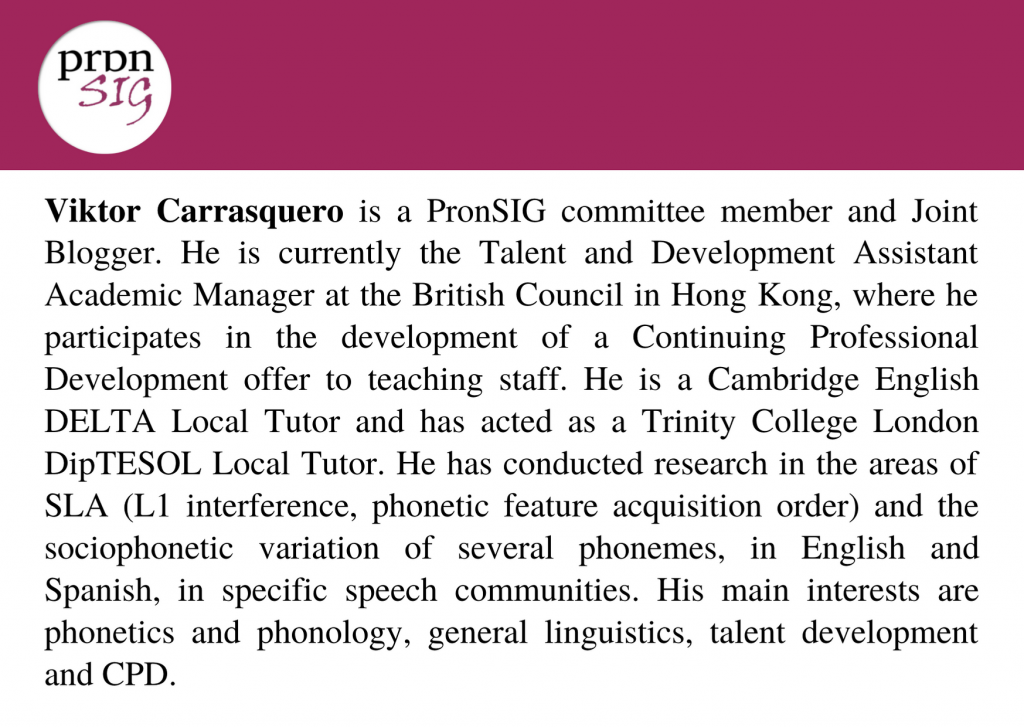Notes on Carol Gonçalves’s webinar ‘A journey through pronunciation and emotions; next stop: ˈmaɪnd.fəl ˈstuː.dənts’.
By Viktor Carrasquero
Pronunciation reflects our feelings and mental states. We let others know how we perceive them and their message by dropping or raising our pitch and volume; we communicate a sense of urgency by speeding up our speech delivery; we express how tired we are by slowing down our tempo. Overall rhythm, intonation, and even the pronunciation of sounds in specific words can be deeply emotional phenomena. On 23rd January, Carol Gonçalves addressed these notions, in a webinar that I found inspiring and thought-provoking. On this entry, I aim to present you with a ‘teaser’ summary of the session, followed by an exploration of mindfulness and, finally, some practical classroom ideas that you can try, expand on and adapt.
The webinar
Before the webinar, Carol kindly accepted to chat with me. She told me about her passion for accents and accent diversity which, she is convinced, learners of English should be exposed to. She also told me about how her experience writing book units, in her graduate course, led her to include empathy, compassion and mindfulness in lessons, as thematic threads.
During the webinar, Carol invited us all on a journey from the heart to the mind, explaining her work context and highlighting emotions as the key concept in the session, which was divided into five parts: 1) Carol had us play The Alphabet Game, eliciting from participants feelings that started with letters of the alphabet; 2) we were involved in a listening activity in which we first predicted people’s feelings, analysing their face expressions and gestures, to then actually listen to their stories, to check our predictions; 3) Carol shared a number of sound perception challenges around minimal pair discrimination; 4) we had a look at how to help our learners develop their confidence and overall listening ability, by exposing them to a variety of accents from people from around the world; and 5) Carol ended the webinar showing us resources we can use to flesh out said variety in our classes. The recording of this webinar is now available on the PronSIG website; click here to watch it in case you have not seen it yet.
Mindfulness: Body, mind and our context
The Cambridge Dictionary states that mindfulness is “the practice of being aware of your body, mind, and feelings in the present moment, thought to create a feeling of calm”. This definition is compatible with the one I found on The Mayo Clinic web portal, which presents mindfulness as “a type of meditation in which you focus on being intensely aware of what you’re sensing and feeling in the moment, without interpretation or judgment. Practicing mindfulness involves breathing methods, guided imagery, and other practices to relax the body and mind and help reduce stress”. One of the elements I like about the latter is the mention of what you are sensing and feeling at the moment, which is, to be honest, perfect for pronunciation teaching! Getting our learners to focus on their body and its reality in our lessons is one of the core objectives of working with pronunciation: by focusing on sound articulation, and on suprasegmental properties of speech, learners have a natural opportunity to put the outside world ‘on mute’, to feel what is within, sense how the different organs of articulation involved in sound production approach one another, how the air coming from the lungs travel through the windpipe, passing through our vocal cords, stimulating them, to being finally restricted or stopped altogether by some obstruction in the mouth… Pronunciation teaching is, actually, a type of mindful meditation!
Some ideas to try
The link between pronunciation, its teaching, and mindfulness is an area that calls for more exploration. I am grateful to Carol for sharing her ideas with us all, and I invite our community to keep finding practical ways to help our learners become more aware of their physicality, their here and now, through pronunciation. In an age of dizzying change and global crisis, it seems more appropriate than ever to help each other connect with our immediate reality, that which we can change, our environment, the processes that we are immersed in. The hope is that this focus and calmness will revitalise us, prepping us to tackle our day with the best of moods and energies. I leave you now with some suggestions you can try -or adapt and adjust:
- ‘Emotional’ roleplay: get your learners to practise overall rhythm and intonation by role playing situations in which they have to show different emotions. Learners can work in pairs or small groups. As someone portrays a given role and acts in a certain way, their peers can guess the emotion represented. An activity that many teachers do is asking students to drill sentences out trying to show different feelings, asking your class to, for example, pronounce “I don’t want to go” as being happy, excited, very sad, etc.
- Proprioception meditation: to raise your learners’ awareness of their organs of articulation, priming them for subsequent work on specific articulatory gestures, ask them to relax (their shoulders, their neck…), to focus on the air that comes from their lungs and their slow breathing… Move on to tell them ‘stories’ about the organs of articulation, for instance: “gently touch that part behind your upper teeth with the tip of your tongue… Leave your tongue there, for a little while… Massaging that bony ridge, that mountain, behind your teeth… Then, slowly, inhale… Get ready to pronounce the first letter of the word tie ([t])… Get ready, but do not say it… Feel the air pressure building up behind your tongue… And there, pronounce the sound, release the air”.
- Connecting with the environment: pronunciation is a compound of very complex physical and cognitive events, which includes the listening skills that we use to decode sound strings. Two foundational skills are sound blending and segmenting, commonly associated with the teaching of reading and writing, but pervasive in the reality of speech. To give our learners practice in this, particularly thinking of our young learners, I have asked students to listen to specific sounds they hear around them. If teaching online, ask your learners to tell you one thing they can hear, and if they can tell what makes that sound. You can also play sounds to your learners, for them to tell you what might possibly be producing them. Such isolation is a stepping stone for blending, which requires some awareness of sounds and how putting them together creates meaningful sequences. This is also a great warmer activity, or a ‘mind break’, both much needed in some of our virtual classes.
I would like to end this post thanking Carol Gonçalves, once again, for shining a light on a path that, as teachers, we should keep exploring. It is not enough to introduce pronunciation features, detached from a situational context nor, more importantly, from the speaker learning how to use it to effectively convey their emotional states. We should go further, in at least two regards: helping learners understand the effect their pronunciation has on others, and finding ways to use pronunciation teaching as a vehicle to lead our classes towards a greater awareness of self, other and their context, on a journey… “from the heart to the mind”.
References
Journal articles
Chen, A. and L. Boves (2018). What’s in a word: Sounding Sarcastic in British English. Journal of the International Phonetic Association, 48/1: 57-76.
Henriksen, N. (2013). Style, prosodic variation, and the social meaning of intonation. Journal of the International Phonetic Association, 43/2: 153-193.
Roach, P., R. Stibbard, J. Osborne, S. Arnfield, and J. Setter (1998). Transcription of Prosodic and Paralinguistic Features of Emotional Speech. Journal of the International Phonetic Association, 28: 83-94.
Websites
Cambridge Dictionary (n.d.). Mindfulness. In dictionary.cambridge.org. Retrieved 29 January 2021, from https://dictionary.cambridge.org/dictionary/english/mindfulness
Mayo Clinic Staff (n.d.). Mindfulness exercises. <https://www.mayoclinic.org/healthy-lifestyle/consumer-health/in-depth/mindfulness-exercises/art-20046356>
Underhill, A. (2012). Proprioception and Pronunciation. <https://www.adrianunderhill.com/2012/08/28/proprioception-and-pronunciation/>


